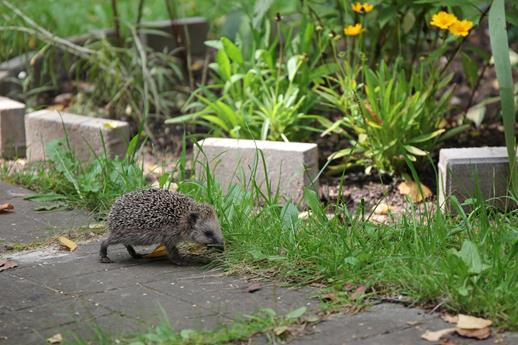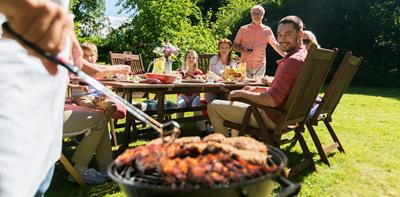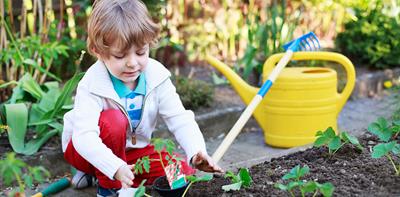
Whatever type of garden you have, big or small, there are plenty of easy ways to attract more wildlife. With today’s environmental challenges, it’s becoming more important than ever for us to all to get involved.
Even the smallest changes can help create habitats for many different species, such as providing them with food and shelter.
So, consider what space you have available and try out some of these steps to make your outside space a haven for many living things.
1. Grow plants for butterflies
Butterflies are not only lovely to look at, but they’re important pollinators too.
You can attract these colourful garden visitors by adding a wide variety of plants that flower at different times of the year.
The Scottish Wildlife Trust suggests choosing plants with simple flowers that make it easy for butterflies to get at the nectar. It says butterflies are attracted to nectar-rich flowers like verbena, and scabious, which are both popular plants for flower beds and borders.
Plus, consider planting a fruit tree; not only is the blossom beautiful, but rotting fruit is a food source for butterflies. And, of course you can eat it too.
2. Use climbing plants
Climbing plants like honeysuckle and ivy add colour to bland fences or walls. They also provide a habitat for small animals and insects, as well as nesting and roosting sites for birds.
One example, ivy, provides leaves for caterpillars including the holly blue butterfly, while the leaves of some species of climbing roses are used by leafcutter bees to line their nests.
3. Get composting
Create a haven for small invertebrates such as millipedes, woodlice and spiders by composting your waste.
Slugs and snails, which are a good food source for many other creatures, may also be drawn to a compost heap. Anything to keep them away from your prized flowers.
You can put your compost to good use too: spreading home-made compost on your garden will encourage more worms, which is good for the soil.
Starting to compost is a double win, as you’ll have also created a sustainable way to get rid of much of your garden and kitchen waste. Find out more about home composting at the Recycle Now website.
4. Help bats
Do your bit to attract nocturnal creatures too, such as bats. According to the Bat Conservation Trust, gardens have become increasingly important for bats as their natural habitats have become more scarce.
To attract bats, you could put up a bat box, or reduce the artificial lighting in your garden.
5. Make way for hedgehogs
Hedgehogs have become a rare sight in many gardens. But you can make changes that will entice them in, providing a safe space for them to nest and hibernate.
Hedgehogs roam far and wide at night, so an easy win is to create a Hedgehog Highway through your garden, This might mean making a gap in a fence or hedge, so be sure to discuss this with your neighbours first.
You can also put out water and food for them. The British Hedgehog Preservation Society recommends meaty cat or dog food, hedgehog food and chopped, unsalted peanuts. It has more tips on making your garden hedgehog-friendly here.
6. Let things grow a little wild
Try and resist the temptation to keep all your garden neat and manicured.
Leave piles of leaves and debris in some places, as these provide both food and habitat for many species.
Avoid mowing your lawn so often. Research shows that cutting your lawn only once every four weeks gives plants like daisies and white clover a chance to grow and flower, which can boost nectar production tenfold.
Why not plant some native wildflowers, which look good and provide another valuable habitat.
If you prefer to have a neat and tidy garden, don’t worry you don’t have to leave your whole garden to go wild. You could try just leaving one part of your lawn to grow longer, and keep the rest in check.
7. Feed the birds
Put out food for the birds. In spring, fat balls are a good choice, while seeds are best in the winter.
Remember that birds need clean, unfrozen water too, you could even consider a bird bath.
8. Grow trees
Trees provide food from their flowers, fruits and seeds, as well as cover and nesting sites for a wide variety of creatures, from insects to birds.
If you don’t have enough space for large trees, then Woodland Trust suggests trying a shrub like dogwood or dog-rose.
9. Add a pond, or small water source
According to the Royal Horticultural Society (RHS) installing a pond is the easiest way to add wildlife value. After all, water is crucial for wildlife.
Ponds can provide homes for amphibians, bugs and garden birds. The Wildlife Trusts has some advice on how to build a pond. You also need to make sure it’s safe if you have young children.
Even if you don’t have space for a pond, you can still provide a water source for wildlife - the National Trust suggests using a buried bucket or trough. But even a small dish of water can be enough for birds and mammals.
10. Give weeding a break
Weeding is a real chore, so here’s your chance to take a break. This is because nettles, daisies and other wild plants that you probably consider as weeds provide food for insects, including butterflies and moths.
And last, but not least, get everyone involved
Creating a garden full of wild things is a family affair. So, be sure to get everyone involved, especially the kids who often love doing their bit to help around the garden.
They can also help you keep track of what new creatures you attract to your garden, so you can measure your success.

